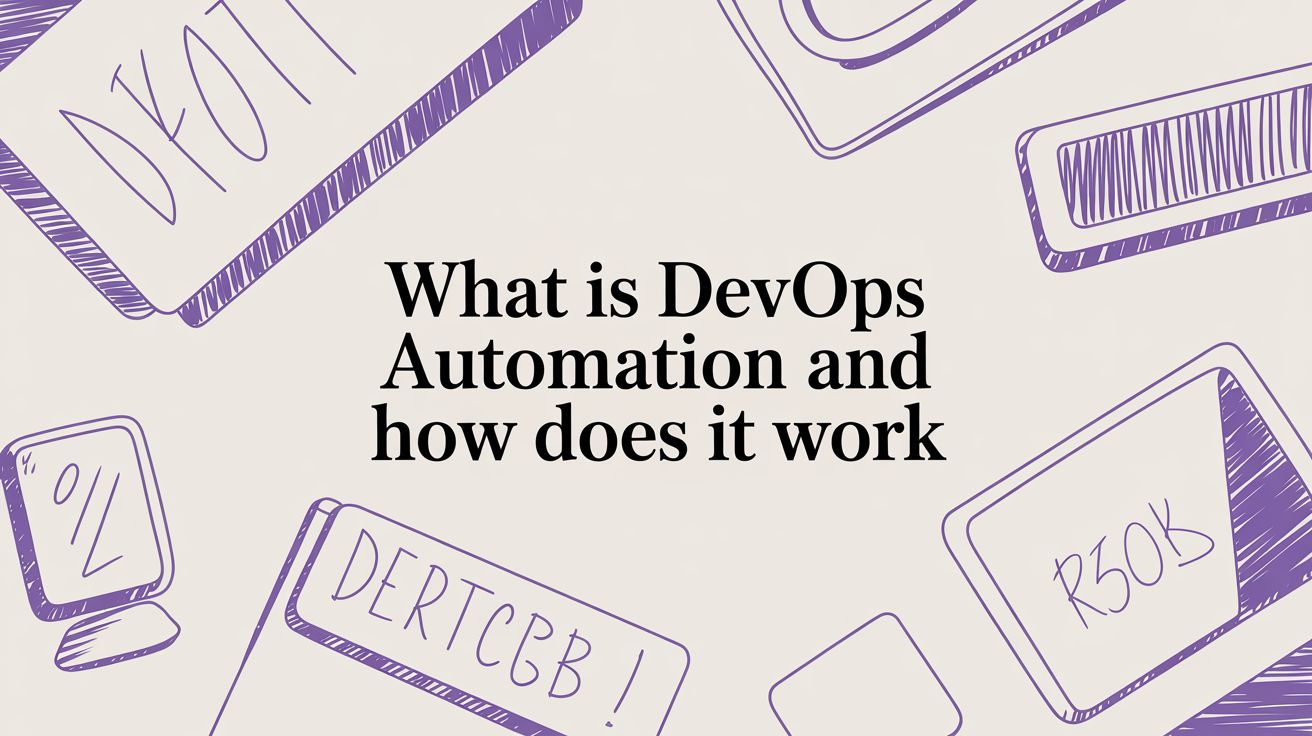What Is DevOps Automation and How Does It Work

By Server Scheduler Staff
5 min read
At its core, DevOps automation is the practice of using technology to perform tasks within the software development lifecycle that would otherwise be done manually. The best way to visualize this isn't as a miscellaneous collection of tools, but as the fundamental transformation of a slow, artisanal workshop into a high-speed, modern assembly line. This shift eliminates bottlenecks, reduces repetitive toil, and empowers your team to build, test, and release software with unprecedented speed and reliability.
Ready to bring that same efficiency to your cloud operations? Server Scheduler helps teams automate routine server tasks to slash cloud costs and boost productivity—no scripting required.
Table of Contents
- Defining the DevOps Assembly Line
- Exploring The Pillars Of DevOps Automation
- How Automation Drives Real Business Value
- Putting DevOps Automation into Practice
- Navigating the Common Challenges of Automation
- The Future of Automation and AIOps
- Frequently Asked Questions About DevOps Automation
Ready to Slash Your AWS Costs?
Stop paying for idle resources. Server Scheduler automatically turns off your non-production servers when you're not using them.
Defining the DevOps Assembly Line
Imagine a traditional workshop where an artisan meticulously cuts, shapes, and assembles every component by hand. The final product might be a masterpiece, but the process is inherently slow, difficult to scale, and nearly impossible to replicate perfectly every time. This is analogous to old-school software development, where building, testing, and deploying code involved countless manual steps, each one a potential point of failure.
DevOps automation completely inverts this model by creating a digital assembly line. The ultimate objective is to construct a self-sustaining system where software progresses from a conceptual idea to a live product with minimal human intervention. This strategic shift liberates your engineers from the drudgery of manual tasks, allowing them to focus their expertise on innovation and creating valuable new features. To understand the gravity of this change, consider the evolution of software testing from Waterfall to DevOps, which highlights how automation became essential for meeting modern demands for speed and quality.

Exploring The Pillars Of DevOps Automation
To truly grasp what DevOps automation entails, it is crucial to understand the foundational components that support it. These can be thought of as the essential pillars that convert a clunky, manual process into a fluid and efficient assembly line for software delivery. While each pillar serves a distinct function, their collective power is realized only when they operate in concert.
The core principles of automation are built upon four key practices that work together to streamline the entire software development lifecycle.
| Pillar | Core Function | Key Tools |
|---|---|---|
| Continuous Integration/Delivery (CI/CD) | Automates the building, testing, and deployment of code changes. | Jenkins, GitLab CI, CircleCI |
| Infrastructure as Code (IaC) | Manages and provisions infrastructure using machine-readable definition files. | Terraform, AWS CloudFormation |
| Configuration Management | Ensures that systems and software are maintained in a desired, consistent state. | Ansible, Chef, Puppet |
| Monitoring and Logging | Automatically collects and analyzes data on system performance and health. | Prometheus, Datadog, Splunk |
This integrated approach is what enables teams to deliver software faster and more reliably.
How Automation Drives Real Business Value
Adopting DevOps automation is far more than a technical upgrade; it's a strategic business decision that yields tangible, measurable returns. By automating the software release process, organizations can ship new features and bug fixes at a much faster pace, enabling them to respond swiftly to market changes and maintain a competitive advantage. This velocity, however, does not come at the expense of stability. In fact, automation enhances it.
Callout: From Cost Center to Value Driver
Automation transforms the IT department from a cost center into a strategic value driver. By delivering better software faster, it directly contributes to revenue growth, customer satisfaction, and operational efficiency, significantly impacting the bottom line.
By removing human error from repetitive tasks, automation dramatically reduces deployment failures and shortens recovery times when issues do occur. This leads to more predictable and reliable outcomes. Furthermore, it frees developers and operations engineers from tedious manual labor, allowing them to focus on high-value work that drives innovation. Recent data underscores this impact, with this comprehensive statistical analysis showing that 99% of organizations report a positive impact from their DevOps practices, including a 61% improvement in software quality.

Putting DevOps Automation into Practice
Theoretical knowledge is valuable, but understanding what DevOps automation looks like in a real-world context is essential. It is not about a single, all-powerful tool but rather a chain of interconnected, automated events that work in unison. This flow typically begins the moment a developer commits new code and continues seamlessly through to production deployment.
A prime example is the CI/CD pipeline. When a developer pushes a code change to a Git repository, it triggers an automated workflow. A CI server like Jenkins or GitLab CI detects the change and initiates a series of tasks: compiling the code, running automated tests to check for errors, and scanning for security vulnerabilities. If all checks pass, the application is packaged and deployed to a staging environment for final review. This entire sequence happens without any manual intervention, ensuring consistency and speed.
Navigating the Common Challenges of Automation
While the advantages of DevOps automation are significant, the journey toward a fully automated pipeline is seldom straightforward. Organizations often encounter obstacles that are as much about culture and people as they are about technology. One of the most common hurdles is cultural resistance. Teams become accustomed to established workflows, and introducing new tools that alter long-standing habits can be met with skepticism. The transition from manual, hands-on processes to a code-driven approach represents a substantial mental shift that requires careful management.
Another significant challenge is the technical skills gap. Building and maintaining a robust automation pipeline demands expertise in areas like CI/CD, Infrastructure as Code (IaC), and container orchestration. Many organizations find that their teams lack this specialized knowledge, which can quickly become a bottleneck. To overcome this, investing in training and fostering a culture of continuous learning is non-negotiable. Starting with small, manageable pilot projects can build momentum and demonstrate the value of automation, encouraging broader adoption.
The Future of Automation and AIOps
The field of DevOps automation is rapidly evolving. We are moving beyond simple task-execution scripts and toward a future defined by intelligent, predictive systems. The next major frontier is the convergence of automation with artificial intelligence, a discipline known as AIOps (AI for IT Operations). This evolution is not merely about accelerating existing processes; it is about creating systems that can anticipate problems and act autonomously.
Instead of an alert waking an engineer at 3 a.m., an AIOps system could predict a potential failure and apply a fix before it impacts users. These systems can analyze vast amounts of data to pinpoint the root cause of an issue, filter signal from noise across thousands of alerts, and even perform self-healing actions without human intervention. This represents a paradigm shift from reactive firefighting to proactive, self-stabilizing operations.
Frequently Asked Questions About DevOps Automation
Even with a clear understanding of the concepts, teams often have specific questions when considering what DevOps automation means for their unique context. Addressing these common queries can help clarify the path forward.
A frequent point of confusion is the distinction between DevOps and automation. It's helpful to think of DevOps as the cultural philosophy and set of practices that align development and operations teams to deliver software more efficiently. Automation, in contrast, is the primary tool used to implement that philosophy. It is the technology that executes the repetitive tasks defined by the DevOps framework. In essence, you adopt a DevOps culture and leverage automation to make it a reality.
When deciding where to begin, the best advice is to start small and aim for an early victory. A great initial project is automating the build and unit testing process through a Continuous Integration (CI) pipeline. This provides immediate value by catching bugs early and helps the team develop the necessary skills for more complex automation projects later on.